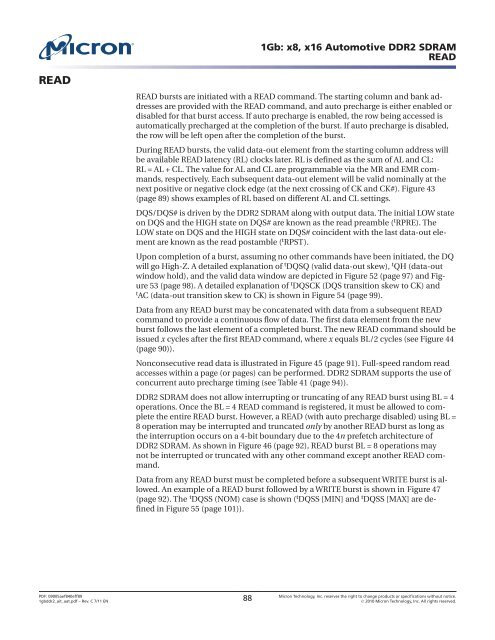1Gb: x8, x16 Automotive DDR2 SDRAM - Micron
1Gb: x8, x16 Automotive DDR2 SDRAM - Micron
1Gb: x8, x16 Automotive DDR2 SDRAM - Micron
You also want an ePaper? Increase the reach of your titles
YUMPU automatically turns print PDFs into web optimized ePapers that Google loves.
READ<br />
<strong>1Gb</strong>: <strong>x8</strong>, <strong>x16</strong> <strong>Automotive</strong> <strong>DDR2</strong> <strong>SDRAM</strong><br />
READ<br />
READ bursts are initiated with a READ command. The starting column and bank addresses<br />
are provided with the READ command, and auto precharge is either enabled or<br />
disabled for that burst access. If auto precharge is enabled, the row being accessed is<br />
automatically precharged at the completion of the burst. If auto precharge is disabled,<br />
the row will be left open after the completion of the burst.<br />
During READ bursts, the valid data-out element from the starting column address will<br />
be available READ latency (RL) clocks later. RL is defined as the sum of AL and CL:<br />
RL = AL + CL. The value for AL and CL are programmable via the MR and EMR commands,<br />
respectively. Each subsequent data-out element will be valid nominally at the<br />
next positive or negative clock edge (at the next crossing of CK and CK#). Figure 43<br />
(page 89) shows examples of RL based on different AL and CL settings.<br />
DQS/DQS# is driven by the <strong>DDR2</strong> <strong>SDRAM</strong> along with output data. The initial LOW state<br />
on DQS and the HIGH state on DQS# are known as the read preamble ( tRPRE). The<br />
LOW state on DQS and the HIGH state on DQS# coincident with the last data-out element<br />
are known as the read postamble ( tRPST). Upon completion of a burst, assuming no other commands have been initiated, the DQ<br />
will go High-Z. A detailed explanation of tDQSQ (valid data-out skew), tQH (data-out<br />
window hold), and the valid data window are depicted in Figure 52 (page 97) and Figure<br />
53 (page 98). A detailed explanation of tDQSCK (DQS transition skew to CK) and<br />
tAC (data-out transition skew to CK) is shown in Figure 54 (page 99).<br />
Data from any READ burst may be concatenated with data from a subsequent READ<br />
command to provide a continuous flow of data. The first data element from the new<br />
burst follows the last element of a completed burst. The new READ command should be<br />
issued x cycles after the first READ command, where x equals BL/2 cycles (see Figure 44<br />
(page 90)).<br />
Nonconsecutive read data is illustrated in Figure 45 (page 91). Full-speed random read<br />
accesses within a page (or pages) can be performed. <strong>DDR2</strong> <strong>SDRAM</strong> supports the use of<br />
concurrent auto precharge timing (see Table 41 (page 94)).<br />
<strong>DDR2</strong> <strong>SDRAM</strong> does not allow interrupting or truncating of any READ burst using BL = 4<br />
operations. Once the BL = 4 READ command is registered, it must be allowed to complete<br />
the entire READ burst. However, a READ (with auto precharge disabled) using BL =<br />
8 operation may be interrupted and truncated only by another READ burst as long as<br />
the interruption occurs on a 4-bit boundary due to the 4n prefetch architecture of<br />
<strong>DDR2</strong> <strong>SDRAM</strong>. As shown in Figure 46 (page 92), READ burst BL = 8 operations may<br />
not be interrupted or truncated with any other command except another READ command.<br />
Data from any READ burst must be completed before a subsequent WRITE burst is allowed.<br />
An example of a READ burst followed by a WRITE burst is shown in Figure 47<br />
(page 92). The tDQSS (NOM) case is shown ( tDQSS [MIN] and tDQSS [MAX] are defined<br />
in Figure 55 (page 101)).<br />
PDF: 09005aef840eff89<br />
1gbddr2_ait_aat.pdf – Rev. C 7/11 EN 88 <strong>Micron</strong> Technology, Inc. reserves the right to change products or specifications without notice.<br />
� 2010 <strong>Micron</strong> Technology, Inc. All rights reserved.

















